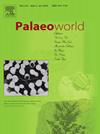对化石骨中骨细胞密度发育模式的定量研究--一种新方法
IF 1.7
3区 地球科学
Q2 PALEONTOLOGY
引用次数: 0
摘要
本研究提出了一种结合定量图像分析、聚类和统计技术的新方法,以研究一种已灭绝的茎类鸟类骨组织特征的二维分布。我们研究的动力是需要绘制中国下白垩统鸟类骨细胞裂隙空间密度的本体变化图。我们特别注重开发工具,以定量揭示这种活跃的飞禽无血管骨骼形成的动态变化。为实现这一目标,我们提出了一种包含以下方法步骤的算法:1) 我们以阴影为标准,对原始图像进行阈值化处理,从而获得像素位置的相关坐标细节。2) 我们使用高斯核估计器估计密度,并通过观察和回归分析对其进行改进。3) 对图像进行切片后,我们采用 K 均值聚类,以获得裂隙密度的一维表示。4) 接下来,我们采用 k 近邻法进行加权平均。应用这些步骤后,我们能够定量地揭示以前未曾注意到的生长过程,并揭示能够进行动力飞行的反鸟类的裂隙骨组织的形成动态。本文章由计算机程序翻译,如有差异,请以英文原文为准。
Quantitative insights into osteocyte density developmental patterns in fossilized bone — A new method
This study presents a new methodology that combines quantitative image analysis, clustering, and statistical techniques to examine the 2D distribution of osteohistological features in an extinct stem-group bird. The driving force of our research was the need to map ontogenetic changes in the spatial density of osteocyte lacunae in the type specimen of Musivavis amabilis from the Lower Cretaceous of China. We particularly focused on developing tools to reveal quantitative aspects of the dynamics in the formation of avascular bone in this active flier. We achieve this goal by proposing an algorithm with the following methodological steps: 1) We obtain relevant coordinate details for pixel locations selected by thresholding the original image with shading as a criterion. 2) We estimate density using the Gaussian kernel estimator and refined it through observations and regression analysis. 3) After slicing the image, we apply k-means clustering to obtain one-dimensional representations of lacunar density. 4) We proceed by implementing weighted averaging employing the k-nearest neighbor approach. Having applied these steps, we are able to quantitatively disclose growth processes previously unnoticed and reveal dynamics in the formation of lacunar bone tissue in the enantiornithine birds capable of power flight.
求助全文
通过发布文献求助,成功后即可免费获取论文全文。
去求助
来源期刊

Palaeoworld
PALEONTOLOGY-
CiteScore
4.00
自引率
5.90%
发文量
95
期刊介绍:
Palaeoworld is a peer-reviewed quarterly journal dedicated to the study of past life and its environment. We encourage submission of original manuscripts on all aspects of palaeontology and stratigraphy, comparisons of regional and global data in time and space, and results generated by interdisciplinary investigations in related fields. Some issues will be devoted entirely to a special theme whereas others will be composed of contributed articles. Palaeoworld is dedicated to serving a broad spectrum of geoscientists and palaeobiologists as well as serving as a resource for students in fields as diverse as palaeobiology, evolutionary biology, taxonomy and phylogeny, geobiology, historical geology, and palaeoenvironment.
Palaeoworld publishes original articles in the following areas:
•Phylogeny and taxonomic studies of all fossil groups
•Biostratigraphy, chemostratigraphy, chronostratigraphy
•Palaeoecology, palaeoenvironment and global changes throughout Earth history
•Tempo and mode of biological evolution
•Biological events in Earth history (e.g., extinctions, radiations)
•Ecosystem evolution
•Geobiology and molecular palaeobiology
•Palaeontological and stratigraphic methods
•Interdisciplinary studies focusing on fossils and strata
 求助内容:
求助内容: 应助结果提醒方式:
应助结果提醒方式:


